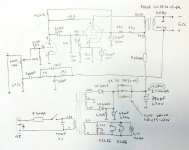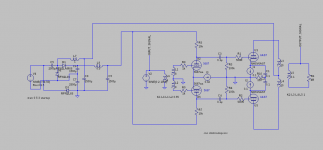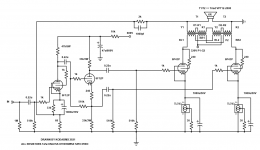The schematic is attached to this post. The 1K resistor on the power supply becomes hot and must be secured to the metal chassis. I choose this arrangement instead of a 210V transformer to avoid a filter choke due to space constraints. I hadn't high expectations because tube manufacturer sample circuits were often tested just on paper or at the lab bench, but the unknown Telefunken engineer that designed this circuit must have tweaked the feedback RC values by ear, because it is not possible to nail the response so nicely just by staring at a oscilloscope screen. It surely knew its job. I selected this Edcor transformer because it is close to the commercially available quality SE transformers of the time.
Attachments
It is marked 1M, but it measures 800k (Kiloohms). Normal tolerance of parts from early '60. I used it because I wanted to build the amplifier as close as the original schematic as possible, but at the end I left the extra tap unconnected: a modern 100K potentiometer will probably work (and will have a better tracking).
I came across this simple rotary switched loudness compensation circuit in the book "Amplifiers" Briggs. For the very low listening levels of nighttime listening.
View attachment Briggs Loudness.pdf
View attachment Briggs Loudness.pdf
The real problem with loudness controls is that the compensation can only be approximate. At best. At worst it can be less than useless. First and foremost, small systems like these probably can’t develop enough SPL to flatten the F-M curves, even when clipping like a son of a. So if you want to hear low bass you *always* need a bass boost for it to appear flat(er). The only question is how much. Then there is the problem with hot signals, which affect everything. Hot signal sources (recording by recording) will force you to use lower settings on the volume control, ones recorded properly will receive less “compensation”. That forces (me anyway) to ride the bass and treble controls. Then I just quit using loudness controls and used the bass and treble as appropriate, depending on desired listening level and amount of bass desired. At low levels I have come to “expect” less bass, so I don’t always turn it up just for “loudness” compensation. Tends to be more when I “want” it or if the recording just needs it. For a “bedroom” system, a good Baxandall tone control set would be all I add.
Maybe there is some digital trickery that can be used to add the “appropriate” amount of loudness compensation based on the average level of the digital bit stream coming in, and the desired volume “setting”. That part probably can’t be done digitally with tubes. An analog equivalent might be possible, but chances are that kind of processing will be the limiting factor on distortion and noise floor of the entire system. And use quite a few bottles and heater power. A digital system can analyze an entire track and make setting adjustments prior to play, analog would be subject to problems like “pumping” as it goes along. Easier to write code, if you were so inclined. Far easier just to ride the bass and treble controls. If you don’t change material often during a session, it’s not that big a burden.
Maybe there is some digital trickery that can be used to add the “appropriate” amount of loudness compensation based on the average level of the digital bit stream coming in, and the desired volume “setting”. That part probably can’t be done digitally with tubes. An analog equivalent might be possible, but chances are that kind of processing will be the limiting factor on distortion and noise floor of the entire system. And use quite a few bottles and heater power. A digital system can analyze an entire track and make setting adjustments prior to play, analog would be subject to problems like “pumping” as it goes along. Easier to write code, if you were so inclined. Far easier just to ride the bass and treble controls. If you don’t change material often during a session, it’s not that big a burden.
wg-ski wrote:
"...The real problem with loudness controls is that the compensation can only be approximate. At best. At worst it can be less than useless. First and foremost, small systems like these probably can’t develop enough SPL to flatten the F-M curves, even when clipping like a son of a. So if you want to hear low bass you *always* need a bass boost for it to appear flat(er). The only question is how much...."
Isn't it much easier then to include a simple tone control and fiddle somewhat with the bass/trebble settings?
"...The real problem with loudness controls is that the compensation can only be approximate. At best. At worst it can be less than useless. First and foremost, small systems like these probably can’t develop enough SPL to flatten the F-M curves, even when clipping like a son of a. So if you want to hear low bass you *always* need a bass boost for it to appear flat(er). The only question is how much...."
Isn't it much easier then to include a simple tone control and fiddle somewhat with the bass/trebble settings?
If someone can show me how to design a "simple" bass and treble control, I'll build it.
30Hz shelving EQ for bass, 16kHz shelving EQ for treble. I don't know how to do that except for parametric EQ or DSP.
This is interesting, but not simple. TC Electronic | Product | ANORM
A Baxandall won't cut the mustard.
30Hz shelving EQ for bass, 16kHz shelving EQ for treble. I don't know how to do that except for parametric EQ or DSP.
This is interesting, but not simple. TC Electronic | Product | ANORM
A Baxandall won't cut the mustard.
Last edited:
If someone can show me how to design a "simple" bass and treble control, I'll build it.
30Hz shelving EQ for bass, 16kHz shelving EQ for treble. I don't know how to do that except for parametric EQ or DSP.
This is interesting, but not simple. TC Electronic | Product | ANORM
A Baxandall won't cut the mustard.
I find that Baxandalls work fine for *me*, but only if I set the corner frequencies two octaves from where mass produced amps put them. Where they usually are, they affect the midrange too much. You don’t have to put them there, you can make the cap values whatever you want. 15 dB boost at 100 Hz (and 9 at 200 along with it) is YUCK. 15 at 25 is niiiiiice, because that limits the boost at 100 and virtually all of it at 200.
But what you may be looking for is a 12dB per octave shelving network, which you cannot make (passive) with just resistors and capacitors. You can get there by by summing the output of a straight path plus a variable amplitude of the output of a 12dB/oct low pass filter (unless you are also allergic to sallen-key filters).
Shelving EQ is probably the only tone control I care for, and that's for setups that specifically need it for baffle step compensation.
A client wanted a tone control in the preamp I'm building him...
I ordered the blank first.
Then I realised it's only 5$ more for a complete. So I bought that. Then I paid Mouser like 60$ for the parts to populate the blank. FML.
12AX7 Dual Channel Baxandall Vacuum Tube Tone Board Type Low Distortion Adjust | eBay
If anyone wants to help change the frequencies from whatever they are to 30Hz/16kHz, I'm all ears
? A Baxandall tone control is already a sliding turnover frequency. It's not possible to make its frequency response slope greater than 6dB / octave.
YOS,
Chris
Loudness controls don’t do better than 6dB per octave either. There is only so much you can do with an R and a C.
To go to 12dB/oct, you need one resonator. To go to 24, you need two. Resonators can be made with an L and a C or two C’s and an *amplifier*. Inductors are big. Amplifiers use power (and potentially use feedback which you may be allergic to). Pick your poison. Baxandalls need amplifiers too. So do passive tone stacks that look like Baxandalls because you need a gain stage to get the level back.
This is my take on a low powered amp. Going to be reconfiguring my old DC7 amp to look like this over the next few weeks. Good for 7W and maybe a bit more. I would say that the tail of the input LTP will need a little negative supply, with it not been ideal.
Shoog
Shoog
Attachments
Last edited:
This is my take on it. I call it The Little Miracle.
The PCB has provisions for triode/pentode with shunt regulated screens, or UL by jumper.
The PSU uses an isolation transformer and a Delon doubler and a quad to make the 320V and 600V respectively. A very nice sound, affordable design.
The PCB has provisions for triode/pentode with shunt regulated screens, or UL by jumper.
The PSU uses an isolation transformer and a Delon doubler and a quad to make the 320V and 600V respectively. A very nice sound, affordable design.
Attachments
Last edited:
- Status
- This old topic is closed. If you want to reopen this topic, contact a moderator using the "Report Post" button.
- Home
- Amplifiers
- Tubes / Valves
- low power bedroom amp


